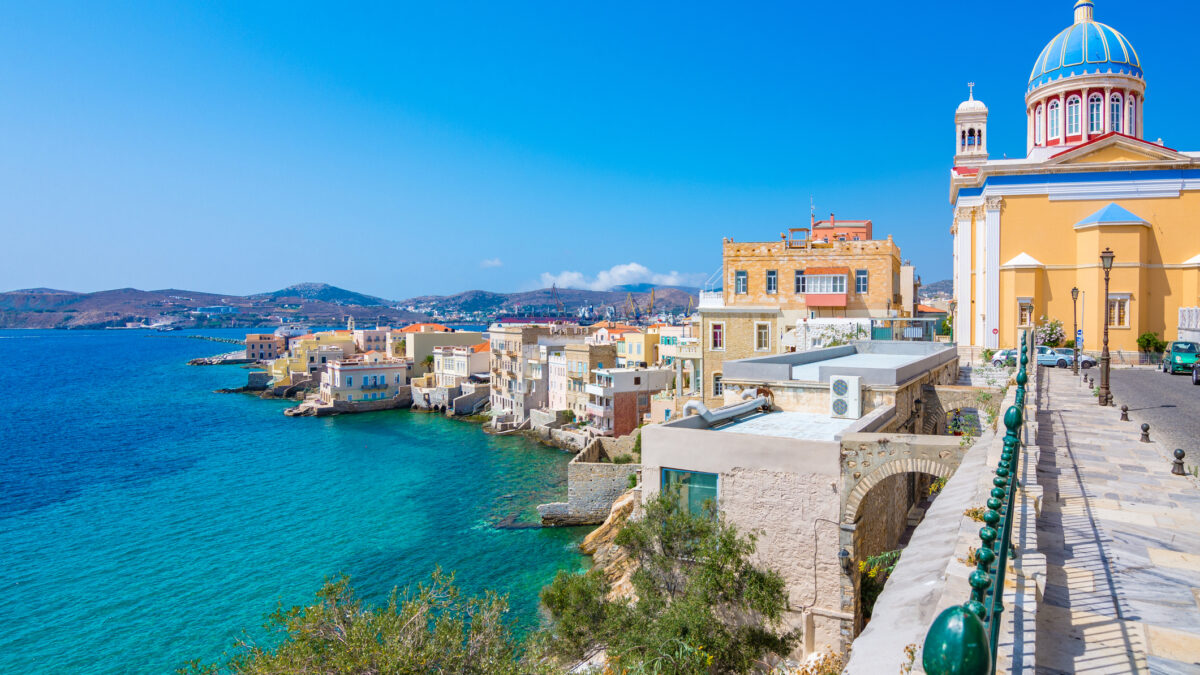The capital of the Cyclades, Syros is a true aristocrat. This is evidenced in the neoclassical manors of Ermoupoli, the medieval town of Ano Syros, the Orthodox side with the Church of the Resurrection that stands on the island’s left hill, as seen from the harbour, with the Catholic San Tzortzis on the right hill, the cosmopolitan past with its traditional elements and poorer neighbourhoods.
Ermoupoli, both the capital of the Cyclades and the island’s main settlement, is a striking fusion of neoclassicism and Cycladic architecture. At its centre, Miaoulis square connects to the steps that lead up to the famous Town Hall, designed by the renowned German architect Ernst Ziller, and the Apollo theatre, inspired by La Scala in Milan. Vaporia, the island’s aristocratic quarter dominated by the striking dome of Agios Nikolaos, has been home to the island’s wealthy shipowners since 1830. Historically, Syros witnessed rapid development after 1826 and the successive waves of refugees from Chios, Psara, Crete and Asia Minor, swiftly becoming the largest commercial port in the newly established Greek state. On the opposite end of the spectrum, Ano Syros is a truly impressive fortified settlement, full of winding alleyways and effortless charm.
The beaches of Syros are family-friendly, sandy, easily accessible and for the most part commercially developed. The island’s most famous beaches include Galissas, Agkathopes, Delfini, Fabrika, Finikas, Kini, Megas Gyalos, Avkaki and the beach directly below Vaporia in Ermoupoli.
Cuisine
The primary element of Syros’ charm is the effective combination of seemingly disparate elements, an aspect that is also present in the island’s culinary heritage. No other island in Greece features such striking flavour contradictions, and their fusion is what makes the result so fascinating. Here, the urban cuisine of the higher classes in Ermoupoli coexists with the rather more modest fare of the farmers and the proletariat. Thus, on the one hand the island exhibits the more urban, European cuisine preferred by the middle class, such as savoro in the oven, while on the other the people’s cuisine is based on seasonal produce and simple cooking methods. And somewhere in the midst of this we find the cuisine of the coffee shops, which serve fried meze that are usually eaten on the go.
The island is especially well known for its cheeses. The cheeses of Syros are rightly considered some of the best in Greece: locally produced cheeses include the famous and rare San Michali, known as the Greek parmesan, and kopanisti, both Protected Designation of Origin (PDO) products, xinotyro, graviera, myzithra and tyrovolia. Also well-known are the island’s cured meats, most prominent of which are its louza and fennel-flavoured sausages. In addition, wild capers, greens and the famous marathia (fennel) are all used to enhance the authentic flavours of Syros.
The island’s cuisine features numerous meat-, fish – and seafood-based dishes, all made with the addition of local aromatics. However, if we had to choose two entirely disparate and characteristic dishes to represent Syros, these would be caper salad and parsley salad. A taste of either offers the essence of Syros in a mouthful.
Naturally, Syros has a storied confectionery tradition, producing such famous sweets as loukoumi and halvadopites. The local marmalades are also considered some of Greece’s best.
How to get there
Syros is an island in the Cyclades and is serviced by ferry from the ports of Piraeus, Rafina and Lavrio. It is also accessible by air.










